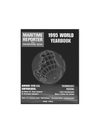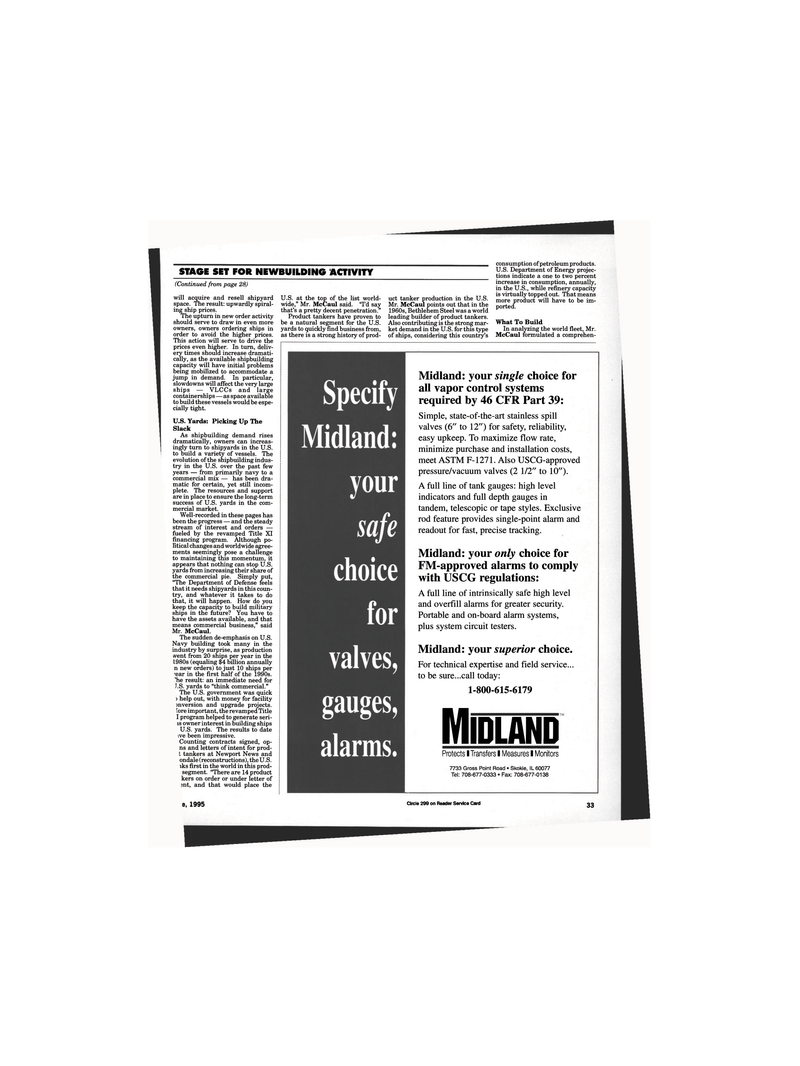
Page 31: of Maritime Reporter Magazine (June 1995)
Read this page in Pdf, Flash or Html5 edition of June 1995 Maritime Reporter Magazine
STAGE SET FOR NEWBUILDING ACTIVITY (Continued from page 28) will acquire and resell shipyard space. The result: upwardly spiral- ing ship prices.
The upturn in new order activity should serve to draw in even more owners, owners ordering ships in order to avoid the higher prices.
This action will serve to drive the prices even higher. In turn, deliv- ery times should increase dramati- cally, as the available shipbuilding capacity will have initial problems being mobilized to accommodate a jump in demand. In particular, slowdowns will affect the very large ships — VLCCs and large containerships — as space available to build these vessels would be espe- cially tight.
U.S. Yards: Picking Up The
Slack
As shipbuilding demand rises dramatically, owners can increas- ingly turn to shipyards in the U.S. to build a variety of vessels. The evolution of the shipbuilding indus- try in the U.S. over the past few years — from primarily navy to a commercial mix — has been dra- matic for certain, yet still incom- plete. The resources and support are in place to ensure the long-term success of U.S. yards in the com- mercial market.
Well-recorded in these pages has been the progress — and the steady stream of interest and orders — fueled by the revamped Title XI financing program. Although po- litical changes and worldwide agree- ments seemingly pose a challenge to maintaining this momentum, it appears that nothing can stop U.S. yards from increasing their share of the commercial pie. Simply put, "The Department of Defense feels that it needs shipyards in this coun- try, and whatever it takes to do that, it will happen. How do you keep the capacity to build military ships in the future? You have to have the assets available, and that means commercial business," said
Mr. McCaul.
The sudden de-emphasis on U.S.
Navy building took many in the industry by surprise, as production went from 20 ships per year in the 1980s (equaling $4 billion annually n new orders) to just 10 ships per r ear in the first half of the 1990s.
Tie result: an immediate need for
J.S. yards to "think commercial."
The U.S. government was quick ) help out, with money for facility inversion and upgrade projects, [ore important, the revamped Title
I program helped to generate seri- is owner interest in building ships
U.S. yards. The results to date ive been impressive.
Counting contracts signed, op- ns and letters of intent for prod- t tankers at Newport News and ondaie (reconstructions), the U.S. iks first in the world in this prod- segment. "There are 14 product kers on order or under letter of snt, and that would place the
U.S. at the top of the list world- wide," Mr. McCaul said. "I'd say that's a pretty decent penetration."
Product tankers have proven to be a natural segment for the U.S. yards to quickly find business from, as there is a strong history of prod- uct tanker production in the U.S.
Mr. McCaul points out that in the 1960s, Bethlehem Steel was a world leading builder of product tankers.
Also contributing is the strong mar- ket demand in the U.S. for this type of ships, considering this country's consumption of petroleum products.
U.S. Department of Energy projec- tions indicate a one to two percent increase in consumption, annually, in the U.S., while refinery capacity is virtually topped out. That means more product will have to be im- ported.
What To Build
In analyzing the world fleet, Mr.
McCaul formulated a comprehen-
Midland: your single choice for all vapor control systems required by 46 CFR Part 39:
Simple, state-of-the-art stainless spill valves (6" to 12") for safety, reliability, easy upkeep. To maximize flow rate, minimize purchase and installation costs, meet ASTM F-1271. Also USCG-approved pressure/vacuum valves (2 1/2" to 10").
A full line of tank gauges: high level indicators and full depth gauges in tandem, telescopic or tape styles. Exclusive rod feature provides single-point alarm and readout for fast, precise tracking.
Midland: your only choice for
FM-approved alarms to comply with USCG regulations:
A full line of intrinsically safe high level and overfill alarms for greater security.
Portable and on-board alarm systems, plus system circuit testers.
Midland: your superior choice.
For technical expertise and field service... to be sure...call today: 1-800-615-6179
MIDLAND
Protects I Transfers I Measures I Monitors 7733 Gross Point Road • Skokie, IL 60077
Tel: 708-677-0333 • Fax: 708-677-0138 e, 1995 Circle 299 on Reader Service Card 33

 30
30

 32
32
